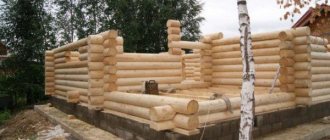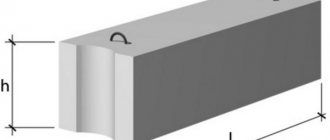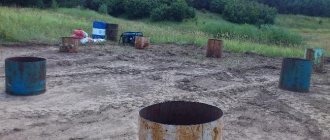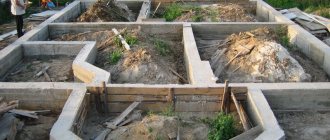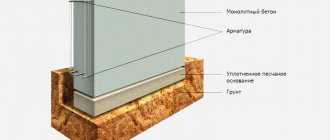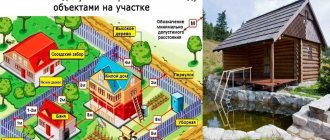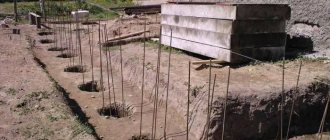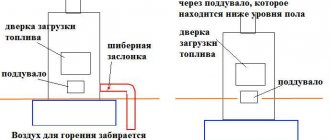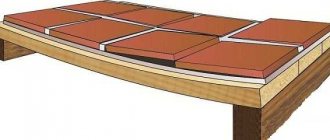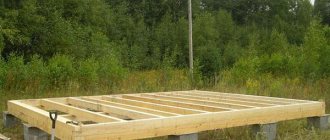More recently, the winter period became a kind of rest for builders. The work stopped, everyone was waiting for suitable conditions to continue. Today, even frosts are not a hindrance, and workers continue to build various structures. Modern technologies have advanced, but ordinary people still argue whether it is possible to pour a foundation in winter.
When it is necessary
If you take this issue seriously, then pouring a foundation in winter turns into a rather profitable undertaking. First of all, there is no need to worry that the walls of the trench will not be strong enough - the soil practically does not crumble. The reason is clear - the frozen soil composition acts as a formwork structure. It happens that in certain areas, excavation work is possible precisely in the cold season, when frost sets in.
Note that foundation work in winter is cheaper, since during the construction season the cost of materials is high, and teams of craftsmen are not idle.
Laying a foundation in winter is the only option to build an object in regions with a harsh climate, when the warm season occurs no more than two to three months. In these cases, preserving the finished foundation for the winter is a stupid and unfounded decision.
Sub-zero temperature and foundation construction
There is no point in arguing with weather phenomena; you need to intelligently adapt to them. That is why the idea arose of developing methods for constructing reinforced concrete foundations in our difficult climatic conditions, possible for implementation during the cold period.
Note that their use will increase the construction budget, therefore in most situations it is recommended to resort to more rational options for constructing foundations. For example, use the bored method or carry out construction from factory-produced foam concrete blocks.
For those who are not satisfied with alternative methods, there are several methods proven by successful practice. Their purpose is to bring concrete to a state of critical strength before freezing.
Based on the type of impact, they can be divided into three groups:
- Providing external care for the concrete mass poured into the formwork until the stage of gaining critical strength.
- Raising the temperature inside the concrete mass until it has sufficiently hardened. This is done through electrical heating.
- Introduction of modifiers into the concrete solution that lower the freezing point of water or activate processes.
The choice of winter concreting method is influenced by an impressive number of factors, such as the power sources available on site, weather forecasters’ forecasts for the hardening period, and the ability to supply heated mortar. Based on local specifics, the best option is selected. The most economical of the listed positions is considered to be the third, i.e. pouring concrete at sub-zero temperatures without heating, which predetermines the introduction of modifiers into the composition.
Advantages and disadvantages
We propose to understand the pros and cons of building a foundation in winter.
Benefits include:
- convenience of preparing a pit or trench in an area where the soil composition does not hold its shape well in the warm season;
- during the winter season, building a foundation in the North is a completely justified decision;
- acceptable cost of materials for which demand temporarily falls;
- availability of free time.
Unfortunately, there are also certain disadvantages. If in the summer it is possible to prepare a trench with your own hands, then in the winter season it becomes necessary to use special equipment to cope with frozen soil. The risk of purchasing low-quality building materials that suppliers were unable to get rid of during the season increases. Added concerns about how to preserve the foundation for the winter.
Different approaches to the question of whether pouring concrete in winter is possible
Discussions periodically arise between builders about the possibility of carrying out concrete work at temperatures below zero degrees Celsius. There are two positions:
- supporters of traditional methods are confident that cement hydration can only occur at positive temperatures. They deny the possibility of using special techniques and believe that in winter the strength of concrete is lower and it is preferable to pour concrete in the fall;
- adherents of the latest technologies do not doubt the effectiveness of proven know-how. They believe that it is possible to concrete the foundation in winter, regardless of the level of temperature decrease, and at the same time ensure the strength characteristics of the foundation.
Each opinion is based on certain views and experiences. Let us dwell in detail on the features of performing concrete measures in cold climatic conditions. The main task is to prevent water crystallization. After all, frozen ice crystals increase the porosity of the mass and create an obstacle to the hydration of the concrete mixture.
Pouring the foundation in winter is quite feasible
What types of foundations are poured in winter?
As a rule, certain types of foundations are built in winter. A common option is a strip foundation, the installation of which in winter has its pros and cons. The main disadvantage is associated with the low level of productivity and the need for frequent rest for the construction team. In addition, certain operations will require significantly more time to complete than in the summer.
It is recommended to minimize the volume of “wet” operations and use ready-made reinforced concrete products.
A pile foundation also has its pros and cons in winter. It is good for light structures built from wood material. If you meet all the requirements of SNiP, in winter you can install a pile-screw foundation on any difficult soil using bored and drilled supports. The first type is concreted into prepared wells, the second is simply driven into the soil. This option is more convenient in that there is no need to mix the solution - the supporting elements are purchased ready-to-use.
Concrete preparation
Not all solutions are suitable for work related to concreting, but only those to which the necessary modifiers have been added.
Their presence allows the concrete mass not to harden ahead of schedule and to have time to gain the required qualities. In addition, the presence of such substances in the solution greatly simplifies the supply of the mixture to the formwork structure.
When choosing modifiers, pay special attention to frost resistance and hardening speed. As a rule, the manufacturer puts such information on the packaging material.
Use of additives
When using them, certain factors are taken into account:
- additives that are resistant to low temperatures reduce the need for water required for preparing the concrete mixture by ten to fifteen percent;
- the minimum temperature regime allowing the use of such additives is twenty-five degrees below zero;
- it is prohibited to use modifiers if the air humidity level exceeds sixty percent;
- take into account the fact that certain types of additives can react with metal;
- By adding additives, you do not eliminate the need for additional measures.
Heating the solution using a welding machine
Implementation of the method using welding equipment
Knowing at what temperature concrete is heated, you can use a welding machine for heating.
To implement this method, you will need the following equipment and materials:
- Several pieces of reinforcement;
- Incandescent lamps;
- Thermometer.
In this case, the fittings are located parallel to the circuit consisting of forward and return wires. Between them there are incandescent lamps, with the help of which voltage measurements will be made. To measure temperature, a very ordinary thermometer is used.
The hardening process of the solution is quite long and can take about a month. During the process of heating and hardening of the solution, the structure should under no circumstances be flooded with water or exposed to cold.
This method is applicable when it is necessary to heat small concrete poured structures and in acceptable weather conditions.
Pouring technology
Soviet engineers figured out how to fill the foundation in winter. The need to carry out such work and the growth of their volumes dictated their own conditions related to the continuity of the cycle, weather conditions, time of year and temperature conditions.
The construction of the foundation in winter was based on three technologies:
- use of heated formwork in winter;
- concreting with a mixture resistant to low temperatures;
- installation of pile supports.
The first option is based on increasing the temperature by artificial means. In this case, it is necessary to install a tent on the site, isolating the heated area from the surrounding air. It is advisable to carry out such construction work at temperatures below five degrees below zero.
In its technical design, winter concreting resembles conventional casting of a monolithic tape. First, excavation work is carried out, after which the formwork is installed, into which the reinforcement frame is laid and the mortar is poured. True, there is one distinctive feature - a heating device is connected to the metal frame, maintaining the temperature of the concrete. After a few days, the tent is dismantled and the heat supply is stopped. The question arises: is it necessary to cover the foundation for the winter? Builders advise covering the entire site with a heat insulator. Resistant to water. This measure will help maintain the temperature of the foundation.
This technology is used in any weather conditions, but its cost increases due to energy consumption. Naturally, pouring without heating is cheaper, but the foundation loses its quality and is only suitable for a bathhouse.
When determining whether it is possible to lay a foundation in winter, many use additive technology. Mortars with such modifiers can be poured without additional heating, because the additives allow the concrete to set even at low temperatures.
Note that for the construction of a columnar foundation in winter, concrete is used, the moisture content of which is reduced, which reliably protects it from frost. And if you still doubt whether it is possible to make a pile foundation in winter, rest assured that such work is completely justified. True, you will have to clarify how to properly preserve the base in order to prevent it from becoming waterlogged.
The process of this method of pouring does not cause any difficulties, but the moisture level of the concrete will have to be kept under constant control.
Whether concrete is poured in winter and how this is done is clear to us. But there is another technology that allows you to build a foundation in winter on screw piles. In this case, there is no need to heat up the concrete, the volume of excavation work is minimized, and you don’t have to worry about how to insulate the foundation for the winter.
Such a foundation can be left unloaded for the winter; it does not require waterproofing.
If you have to pour a foundation for a bathhouse, consider this technology.
How to pour a foundation in winter: we will learn from practical actions how to pour a foundation in winter
Traditionally, building a house has always been a “summer” activity, and among private developers, few even thought of starting active work in the winter. However, it just so happens that Russian winters are quite long, and in some regions the cold season generally reaches a period of 6 ÷ 8 months. And if you exclude them from the process of constructing a building, then the construction of a house can take several years. To speed up this process, special technologies have been developed and special materials have been produced that make it possible to start concrete work or not stop it even in the winter cold.
How to pour a foundation in winter
However, in order for the foundation of the building to be reliable and monolithic, you need to very accurately understand how to pour the foundation correctly in winter. Knowing all the nuances of this rather complex process and following all the technological recommendations, you can start working at low temperatures so as not to waste winter time in vain. Often, starting construction during this period, the owners expect to move into a finished new house by the fall.
In addition to the need to speed up the construction of a house, the need to fill the foundation in winter may also be due to specific reasons. For example, such measures are also resorted to due to the fact that the soil in a given area is characterized by increased flowability, so it will be much more convenient to work with it when it is in a frozen state.
When laying the foundation, you need to remember that it is not recommended to install a columnar structure in winter, since small volumes of concrete, when hardened, are incapable of retaining heat in any way and quickly cool down, disrupting the hardening and maturation processes of the solution. That is why, if the foundation is poured at sub-zero temperatures, you need to choose a monolithic or strip option.
It is necessary to begin work on laying out the foundation for the construction of a house with preparatory work, which in winter is usually characterized by increased labor intensity.
Preparatory work
- The place where it is planned to build the building must be cleared not only of snow, but also of the surface layer of soil.
- Next, a general marking of the cleared area is carried out - this is done by installing pegs on which a marking cord is pulled - it will visually indicate the external dimensions of the future foundation.
Carrying out marking and tracing work at the construction site
The next step is marking the width of the required trench - also with installing pegs and pulling the rope. To make it convenient to dig a foundation pit, its inner boundary is outlined along a stretched rope, and an even strip is hollowed out in the ground along it using a hammer drill or a pneumatic jackhammer - this will mark the edge of the foundation.
- Next, a trench is dug, which must have a depth of at least 500 ÷ 750 mm. The depth is usually calculated depending on the type of soil.
If the soil cannot be shoveled, then you should gradually crush it with a hammer drill or pickaxe. In this case, the earth is removed from the pit in layers.
- When the trenches are completely dug, they are prepared for pouring concrete. To do this, sand is poured into the bottom - it must be dry, so you need to choose material that was stored indoors or at least under a roof. The sand cushion will be an excellent waterproofing layer for a strong foundation if it is well compacted. After compaction, the layer thickness should be 80 ÷ 100 mm.
A layer of crushed stone of the same thickness is poured onto the sand cushion and also thoroughly compacted.
- Next, from the bottom of the trench and to the height of the future foundation, formwork is built from boards. If smooth, high-quality boards are used for it, which are tightly fitted to each other during assembly, then additional insulating materials do not seem to be required.
Formwork for a “winter” foundation with a reinforcing belt
If cracks have formed between the boards, and there is a risk of mortar leaking through them, then it is best to waterproof the formwork with a plastic film with a thickness of at least 200 microns before installing the reinforcement structure.
It would be more expedient to provide a layer of film waterproofing on the inner walls of the formwork
Good advice is to use such an insulating layer in all cases. It will maintain the correct water balance in the concrete solution (water will not flow out or be absorbed into the formwork material), and the maturation of concrete will proceed more evenly and efficiently.
We recommend that you familiarize yourself with the detailed technology for constructing formwork for the foundation with your own hands. This article describes the main tasks of formwork and the technology of its step-by-step construction.
In addition, we advise you to pay attention to the material - about waterproofing the foundation, because... It is waterproofing that will preserve the integrity of the foundation for many years.
Another option for waterproofing formwork is to use ordinary inexpensive roofing felt.
- You can often use permanent formwork made of polystyrene foam separately for foundations, which will at the same time act as insulation for the mortar being poured and will not allow it to quickly harden. The hardening process will take place gradually, which is very important for the strength of concrete.
A modern convenient solution - permanent formwork made of hollow polystyrene foam blocks
- Next, a structure of reinforcing bars is mounted into the prepared formwork, which are connected to each other by welding or twisting wire. For this design, metal rods with a diameter of 8 to 15 mm are suitable - this parameter will depend on the width of the foundation and the planned design load on it.
After all the preparatory processes have been carried out, you can begin to calculate the consistency and component composition of the solution. These parameters are selected depending on the approximate temperature at which concrete work will be carried out.
Pouring concrete
When preparing a solution, it is necessary to take into account such factors as the brand of the solution, the outside temperature, the quality of the material, and special additives that can delay the crystallization of water at low temperatures. Without taking into account all these nuances, the solution after hardening will not be as strong and durable as planned, since it will quickly begin to crumble. In this case, the work will have to be completely redone, because such a foundation simply will not withstand the load from the walls.
- To mitigate the effects of low temperatures, after installing the formwork, before pouring concrete into it, a temporary tent is erected over the structure. Its frame can be put together from boards and timber - the base must be rigidly installed and have a height higher than human height, since the builder will have to work under it. Metal parts – profiles and reinforcement – can also be used for a temporary frame.
A tent over the poured foundation will allow you to maintain at least the minimum required temperature.
From the outside, the structure is covered with reinforced polyethylene film, which has sufficient strength to withstand wind loads and the weight of snow cover. The roof of the awning must have a steep enough slope so that precipitation does not linger on it, otherwise even the reinforced film can tear, and the presence of an awning will simply lose its meaning.
The sheets of film covering the foundation must be securely fastened together, or even better, purchase or rent a ready-made specialized awning, which you simply need to install over the structure.
Awnings for the construction of a temporary tent in folded form
Such a temporary tent will allow you to maintain the required temperature for the solution to gradually harden without the risk of freezing, that is, the tent will become a kind of greenhouse that will trap heated air. In severe frosts, under such shelter you can turn on heating devices, for example, heat guns.
Maintaining the temperature can be achieved by installing an electric or gas “heat gun”
To pour concrete, it is necessary to create a temperature in the tent of at least 5°C; for concreting without the use of antifreeze additives, it is critical. Lower temperatures will lead to crystallization and destructive processes.
But even at a critical temperature, the setting of concrete and its hardening will take much longer, therefore, if it is possible to postpone the pouring of the foundation to warmer days, then it is recommended to do so. By the way, if you analyze the table with the maturation times of concrete under different temperature conditions, you can see that the time gain in some cases will be very insignificant.
- When pouring the foundation in winter, it is recommended to use finely ground cement to prepare the mortar, which generates more heat when reacting with water and additives than regular cement. To mix concrete, it is best to use water heated to 40 ÷ 80 degrees.
| Brand of cement used | Temperature of water when preparing the solution | Temperature of concrete when leaving the concrete mixer |
| Portland cement; slag-Portland cement; Portland cement grade below 600 | 80 | 35 |
| Rapid-hardening Portland cement and Portland cement grades below 500 | 60 | 30 |
| Aluminous cement | 40 | 25 |
When mixing a solution with hot water, it is first mixed with additives, and then introduced into the cement in parts and mixed thoroughly. since increasing the time for preparing the solution helps to maintain the desired temperature in the solution for a longer period. A homogeneous mass of solution better fills the entire space of the formwork, as its fluidity increases.
Medium or small crushed stone is often added to a thin, well-mixed concrete solution, which will add the rigidity necessary specifically for the foundation.
Crushed stone of small or medium fraction is often added to the foundation solution.
In addition to crushed stone and additives for frost resistance of concrete, plasticizers are often added to it; they contribute to the strength and moisture resistance of concrete, as well as its adhesion to reinforcing structures. Thanks to plasticizers, it is possible to reduce the consumption of cement mortar by 25%.
- Another way to keep the foundation warm is to connect it to a 12-volt electrical cable. It will heat up the reinforcement bars, which in turn will give off heat to the solution, preventing it from freezing. The significant disadvantages of this heating method are the complexity and cumbersomeness of the preparatory work, the need for special equipment, the wasteful use of electricity, and therefore very significant financial costs.
- You can hear many different opinions about the benefits of special anti-freeze additives in concrete mortar, they say, they make it possible to pour the foundation in conditions of negative temperatures without any other measures for temporary insulation of the structure. Is this so, and what are anti-frost additives in concrete?
Will antifreeze additives solve the full problem?
Alas, no... These are special chemical compounds that solve two main problems. Firstly, they increase the density of the aqueous base of the solution, which means they sharply lower its freezing point. Secondly, they contribute to a kind of catalysis of the concrete ripening process by more actively involving air oxygen molecules in the reaction precisely under conditions of low or even negative temperatures.
In construction practice, sodium nitrite or formate, potash, calcium hydrochloride, and lignosulfonate are usually used to prepare “winter” solutions. Such reagents can be purchased in specialized stores, but preparing high-quality concrete on your own, without special equipment, without special calculation methods and correct dosage, is extremely difficult, to say the least. An incorrect component ratio can completely ruin concrete, which, even under the most optimal hardening conditions, will turn out to be brittle, crumbling, loose, etc. In addition, it must be borne in mind that the use of special additives can have a “detrimental” effect on the condition of the reinforcement - not every metal is suitable for these purposes.
Another consideration that is not at all in favor of antifreeze additives. Yes, they allow certain technological processes to be carried out at subzero temperatures. However, this does not mean speeding up construction work. Take a look at the table - it shows the approximate time frame for concrete to gain grade strength at low temperatures using antifreeze additives:
| Type of antifreeze additive | average temperature during ripening | 1 Week | 2 weeks | 4 weeks | 3 months |
| Sodium nitrite | -5° C | 30% | 50% | 70% | 90% |
| -10° C | 20% | 35% | 55% | 70% | |
| -15° C | 10% | 25% | 35% | 50% | |
| Potash | -5° C | 50% | 65% | 85% | 100% |
| -10° C | 30% | 50% | 70% | 90% | |
| -15° C | 25% | 40% | 60% | 80% | |
| -20° C | 23% | 35% | 55% | 70% | |
| -25° C | 20% | 30% | 50% | 60% |
Conclusion: even with relatively mild frost - about -5°C, and with the use of anti-frost additives, it is possible to talk about the readiness of the foundation to continue any further construction work only after 3 months. So, does it make sense in the context of private construction to rely on such technology if there is practically no gain in time, and the quality of the solution can significantly decrease? What is profitable and justified during large-scale industrial construction with its laws of planning and logistics, in the conditions of a private small construction project can turn out to be a completely unjustified, unnecessary waste of effort and money.
Prices for various types of antifreeze additives in concrete
Antifreeze additive in concrete
Video: pouring a strip foundation in winter
Some important recommendations
So, let's go back a little to the advisability of pouring the foundation in winter. It is usually carried out in the following situations:
- Construction must be completed within a strictly defined time frame, without the possibility of postponement.
- The climatic conditions of the area where construction is taking place are unsuitable for carrying out this process during normal summer periods.
- Loose soil makes it extremely difficult to construct a foundation in the summer, and it can only be built in hard, frozen soil that can maintain the desired shape of the trench for a long time.
- Saving money, since in winter the prices for building materials are much lower.
- Construction companies reduce prices for their services in winter, due to the lack of a large number of requests for work.
Before starting work, it’s worth weighing everything very carefully - wouldn’t it be more profitable to postpone the start of pouring to spring?
But, despite the above arguments for saving on materials, building a foundation in winter will always cost more than at above-zero temperatures, since large amounts of electricity will be required for heating. Therefore, when planning these events, you first need to carefully calculate everything and choose the option that will not only help you save personal funds, but will also create comfortable working conditions.
If you still decide to fill the foundation in winter, then you need to know some of the nuances of this process that will help create a high-quality foundation for the future building:
- The materials used in the preparation of the solution must be of high quality. It is unacceptable for the components to be frozen, with inclusions of snow or ice. Therefore, it is worth purchasing components for the solution that were stored only in the right conditions and at positive temperatures.
Better yet, don’t bother with preparing “winter” concrete yourself, purchasing a ready-made solution balanced for specific conditions of use from local manufacturers.
- The solution is poured into the formwork at one time and, if possible, as quickly as possible, so that negative temperatures do not have time to affect the ingredients of the solution.
This is another argument that it is impossible to prepare and pour a large amount of mortar on your own at one time - it is better to take advantage of the offers of companies that will manufacture, deliver and pour concrete into the formwork. You will only need to quickly distribute the solution over it yourself.
It is almost impossible to independently prepare a solution for “winter” pouring of the foundation, since it is necessary to quickly and uniformly fill the entire volume of the formwork
- You cannot pour the solution in layers, as cracks may form between them, into which moisture will penetrate, and at low temperatures it will turn into ice, which can destroy the hardened concrete.
Concrete maturation processes
Concrete poured and distributed over the formwork goes through two stages until it is completely ready - setting and hardening.
- The first stage takes place within 20 ÷ 30 hours. At this time, the concrete becomes more dense, but not strong enough for further work.
- The second stage is the hardening and beginning of hardening of the concrete, since the latter lasts quite a long time. The hardening period depends on temperature, humidity, quantity and quality of additives, as well as the brand of concrete solution.
The most favorable temperature for pouring and hardening of concrete is considered to be from + 15 to + 25 degrees, and the closer it is to the highest point in a given “corridor,” the faster the hardening and hardening will take place. It is clear that creating such conditions in winter is simply unrealistic.
The grade of concrete determines its strength 27–30 days after it is poured, if the work was carried out under optimal temperature and humidity conditions. The higher the grade of the solution, the faster the foundation will be ready.
The rate of hardening and maturation of the solution directly depends on the temperature at which these processes take place. If the temperature changes, the processes slow down or speed up along with it. Strengthening of the finished foundation proceeds faster if the poured mass is maintained at an optimal temperature for this process using heating.
It is also necessary to take into account that if the temperature in concrete drops below + 4 ÷ 5 degrees, then the maturation processes slow down almost to a minimum, freeze, and can continue again only when external conditions are normalized. However, such jumps have an extremely negative impact on the structure of the created concrete structures.
At negative temperatures, the hardening of concrete stops completely, since it is mixed with water, and it crystallizes. When positive temperatures return, the concrete thaws and hardening may continue, but there will no longer be an optimal combination of materials and the required strength of the foundation.
Only after the concrete in the foundation structure has completely hardened will it not be afraid of any frost.
For greater clarity, here is another table that shows how temperature conditions affect the maturation of concrete structures. You can roughly estimate the timing of the work in order to make a preliminary conclusion whether it makes sense to get involved with laying the foundation in winter.
| concrete hardening time, days | -3° C | 0°C | +5° C | +10° C | +20° C | +30° C |
| 1 | 3% | 5% | 9% | 12% | 23% | 35% |
| 2 | 6% | 12% | 19% | 25% | 40% | 55%٭ |
| 3 | 8% | 18% | 27% | 37% | 50%٭ | 65% |
| 5 | 12% | 28% | 38% | 50%٭ | 65% | 80%٭٭ |
| 7 | 15% | 35% | 48%٭ | 58% | 75%٭٭ | 90% |
| 14 | 20% | 50%٭ | 62% | 72%٭٭ | 90% | 100% |
| 28 | 25% | 65% | 77%٭٭ | 85% | 100% | — |
A few explanations about the table:
- The percentages are calculated based on the reference brand strength for concrete mortar M200 - M300 made from Portland cement M-400 or M-500 without the use of additives.
- Values with one asterisk (٭) are the conditional terms for the possible removal of formwork of a poured foundation without the risk of deformation of the structure.
- Values with two asterisks (٭٭) are the possible time frame for resuming safe construction work on a poured foundation.
Cement prices
Cement
Video: example of pouring a foundation in winter
Having learned all the nuances of pouring concrete in winter, we can come to the conclusion that the best option would still be to carry out this technological process at favorable temperatures. If this needs to be done precisely at this time, then it is better to entrust this stage to professional builders who have experience in such work and the appropriate special equipment. Amateur work in such a matter can be extremely destructive - a huge amount of amateurishly done work can simply be ruined.
Preservation of the foundation for the winter
It is necessary to understand how to prepare the poured foundation for the coming winter.
Actions related to deciding how to preserve the foundation for the winter are most often directed at how to cover concrete, especially that built on heaving soil. If the soil was not replaced with a sand cushion before pouring the base, there is a possibility that the structure will collapse. And if you doubt whether it is possible to leave the foundation for the winter without load, then you have already received the answer to your question.
Prevent the possibility of destruction by erecting temporary shelters. How to cover the structure, everyone decides for themselves - hay, expanded clay, straw, slag and other materials are suitable for this. An excellent solution is to insulate the foundation strip for the winter with sawdust.
How to prepare a strip foundation for winter? As soon as the concrete hardens, the formwork panels are dismantled. Conservation of the structure is carried out in several stages:
- A reliable waterproofing barrier is constructed from roofing felt or polyethylene. The material is laid on the foundation with an overlap, pressed down so that it does not blow off the wind;
- foam plastic is laid under the waterproofing or expanded clay stone is poured so that the heat in the concrete is retained for as long as possible.
If you decide to leave the foundation for the winter, you should take care to drain excess water from it. To do this, a pit is built a few meters away, and trenches are connected to it, designed to collect moisture.
Remember that only the foundation that has managed to gain final strength is insulated for winter.
How to protect a screw pile foundation for the winter? It is believed that such a design is not dangerous from frost, and such work is not necessary.
Heating the solution with wire
The photo shows an example of wire laying
To implement this heating method, you will need a PNSV wire, the price of which is low.
This wire consists of only two structural elements:
- Single-wire conductive rounded steel core;
- Insulation made from PVC or polyethylene.
This method is based on the transfer of heat to the concrete mass from a heated wire. The heating of the wires themselves is realized using transformer substations with a control system. This system allows you to adjust the heating temperature while working with the solution depending on the ambient temperature.
Wire solution heating technology
The instructions, which stipulate how to connect concrete heating, provide for the following stages of work:
- The wire is laid in the structure before it is filled with mortar, so that it does not come into contact with the formwork . The ends of the wire must protrude from the concrete surface for connection;
- The soldering method is used to remove the ends of the heating wires;
Advice. To preserve the thermal field, solder joints should be wrapped with metal foil .
- The number of heating wires and the length of each of them is taken from the calculations and technological maps;
- To ensure uniform load, a test check of the heating structure is carried out using a megger;
- Current is supplied to the wires through a step-down transformer substation.
Heating wire location
To implement this method, it is necessary to draw up an individual technological map for each design.

